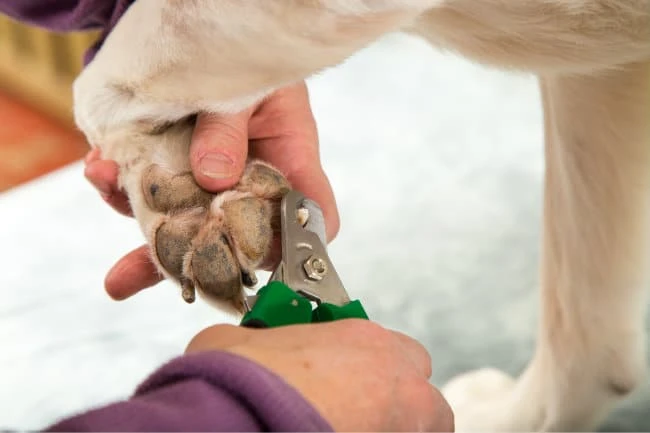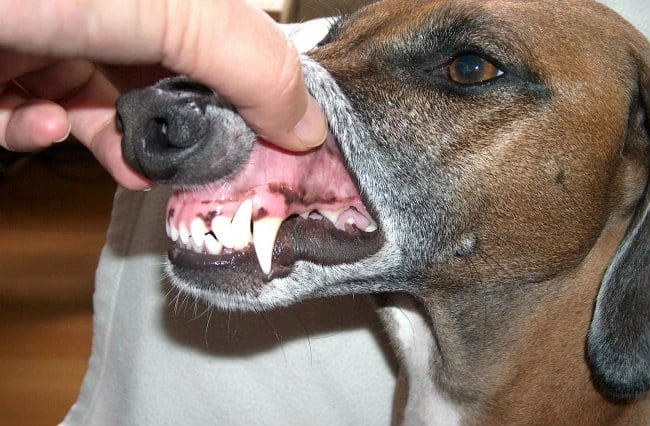The Dog Owners Guide To Guide to Canine Nail Fungus

Canine nail fungus is a fungal infection that is caused by the fungal microorganism Blastomyces dermatitidis. This health problem is often seen in sporting and working dogs (and is more often seen in males than females but the reasons for this are unknown).
The main reason working dogs are more prone to this condition is because they live a ‘working’ and active lifestyle that makes them more prone to coming into contact with the areas that the fungal microorganisms grow i.e. in moist dark places (like rotting trees and dead plants), streams, rivers and creeks where the Ph levels are low.
What are the symptoms of canine nail fungus?
The main symptoms of this condition can include intensive itching – your dog might lick, scratch and paw at the infected nails. However, it is also possible that there are no symptoms at all – it depends on the level of infection.
This condition can also affect humans causing the nails to become a little discolored and brittle – it’s the same for your pooch. If you think that you dog has been infected with the fungal infection – look at where you walk your dog – if you walk your dog near most dark areas you will be able to determine whether your pooch is more susceptible and may have contracted the infection. Of course if your pet has contracted the condition then you will need to avoid the areas that you walked him or her in future.
How is canine nail fungus diagnosed?
Diagnosing this condition is actually one of the easiest for your vet to perform – the vet will normally take a small clipping and biopsy which will then be tested under a microscope to see if your pooch’s nails have been infected by the microorganism Blastomyces dermatitidis.
Treating & Preventing Canine Nail Fungus
There are a variety of natural and conventional treatments that can be used to treat this condition. The most common method to treat the infection will involve a topical creme being prescribed. The creme will then be smeared and rubbed into the infected nails making sure that they are covered properly – the vet will show you how to use it properly.
Another treatment that is often prescribed by vets is a spray – however it depends on your vet as either treatment will be effective – the main ingredient in the spray and creme will be anti-fungal properties.
One of the problems of having topical treatments is the risk that your dog will attempt to lick off the creme or spray – to stop this from happening it might be neccessary for your pet to wear one of those very fetching cones.
Of course one of the best ways to stop your dog from getting infected is to avoid walking your dog in areas that the microorganism are found – try and stick to areas that are dry – avoiding moist areas where the Ph levels are low. If you do happen to encounter an area where you think your dog might pick up the fungal infection make sure when you return home you wash your dog’s paws thoroughly.
A home remedy that some owners swear by is to wash their dog’s feet, paws and nails with apple cider vinegar mixed with water. Vinegar is a natural antiseptic and is a fantastic natural home remedy to kill germs and any possible fungal infection. Please remember that is vital that you speak to your vet before you treat your dog from home.
Another way to help prevent the chances of your dog developing nail fungus is by feeding your dog a healthy, balanced diet that is rich in essential vitamins and minerals – this will help to boost your dog’s immune system.
Canine nail fungus is not the only nail problem that can affect dogs. It is very important that you keep a close eye on your dog’s nails as they can easily become over grown which can lead to them breaking, cracking or becoming split which will allow dirt and possible infection to take hold.
Of course active dogs that are constantly on the move tend to wear down their nails so they won’t need to be clipped. If however your pooch is less active it is important that the nails are clipped when they become too long – the best way to do this is to pay for a dog groomer to do it for you – this way you will know that they are being clipped properly.
Cracked nails not only affect humans they can also affect dogs too – this might be due to a lack of the right vitamins and minerals. As previously mentioned if you are not sure if your pooch is getting all of the right nutrients it might be worth speaking to your your vet as they can advise on the best diet and even prescribe supplements.
Torn nails are also a painful and nasty condition that can affect some dogs. When a dog tears the nail it can expose the soft ‘Quick’ that is found beneath the nail coating. The ‘Quick’ is where all of the nerves and blood vessels are found – so when it has been exposed the pain for your pooch is unbelievable. If you think that the ‘Quick’ has been exposed you will need to take your dog to the vet for it to be treated.
Dogs that develop systemic fungal infections can develop a fever and it is not uncommon for some dogs to lose weight and appear lethargic.
It is important to mention that all fungal infections can cause skin problems most commonly characteristic lumps and bumps that may at times exude a nasty pus like discharge. Out of the four most common fungal organisms it is Blastomyces and Coccidioides that are more likely to cause skin problems in dogs.
One of the most common types of fungal infections to affect dogs is Dermatophytosis (also known as ringworm). The term ‘dermatophytes’ literally means ‘skin fungi’ and also refers to a condition that not only affects dogs but people too.
About fungal infections in dogs
Fungal infections can develop into serious health conditions. As previously mentioned dogs that are prone to digging are more likely to come into contact with potentially dangerous fungal organisms. Although most dogs that have a fairly strong immune system are able to fight off fungal infections, if their immune system has become weak due to a previous infection or illness the fungal infection can lead to serious health problems including arthritis, bone infections and even pneumonia.
Although most fungal infections tend to only affect the skin some can also affect the respiratory system because the infectious spores are breathed into the lungs where they then affect other tissues. The most dangerous fungal infections to affect dogs (that are contacted via the environment) include Blastomycosis, Coccidioidomycosis, Cryptococcsis, Histoplasmosis and Sporotrichosis.
Each type of fungi may cause different symptoms. For example Coccidioidomycosis tends to affect the bones which can then lead to lameness. Dogs that contract Blastomycosis can develop eye problems and dogs that become infected with Histoplasmosis can develop digestive problems as the fungal infection tends to congregate in the intestines.
Did you know?
A type of fungal infection known as Cryptococcosis can lead to neurological problems as the infection tends to congregate in the brain, spinal cord and around the dog’s nervous tissues.
For your beloved canine nail fungus is a very irritating health condition that needs treatment to alleviate and cure the symptoms and underlying problem.
Microsporum canis which is a type of fungi often passed to dogs through contact with a cat.
Microsporum gypseum which is contracted with contaminated soil.
Trichophyton mentragrophyteswhich is a type of fungal infection contracted via infected rodents.
One type of rare fungal infection known as Zygomycosis is contracted via exposure to contaminated water and soil and will affect the tail and other extremities. There are also fungal infections that can develop under the skin which are known as Subcutaneous mycoses.
If a dog is exposed toMycetomas these cause the affected dog to develop draining lesions on the feet and legs.
Aspergillosus is a type of fungal infection that can lead to respiritory symptoms and also lesions in the nasal cavity (these can develop further into ulcers).
Below is a guide to other foot problems that affect dogs
Interdigital eczemza is an infection that occurs on the feet and toes. Dogs have a tendency to lick their feet if the feet become injured or a foreign object gets stuck in the foot (thorns are a common caused). Unfortunately the constant licking makes the foot really wet leading to an infection in-between the foot pads.
As the infection takes hold all this is does is to perpetuate the situation as the pain causes the affected dog to continue licking the affected area. If this continues the dog will become lame. The normal treatment for interdigital eczema will involve the vet clipping any hair, cleaning the affected area and then removing any foreign object (such as a thorn). The area will also need to be bandaged to stop the dog from licking the injured foot. The vet may also prescribe anti-inflammatory and antibiotic medicated cream.
Interdigital cysts are another problem that can affect a variety of breeds including Bull Terriers and Dobermanns. The cysts develop in-between the toes and can burst spontaneously and can lead to lameness. Treatment for this condition may involve the cysts being lanced and then anti-inflammatory and antibiotic drugs prescribed. The cysts may also need surgery. It is also thought that breeds that have less space in-between their toes can cause this problem due to the constant friction when walking.
Dog Health Problems Online > Canine Nail Fungus




